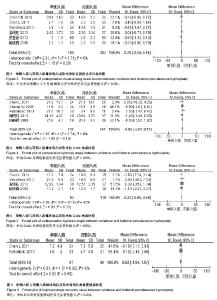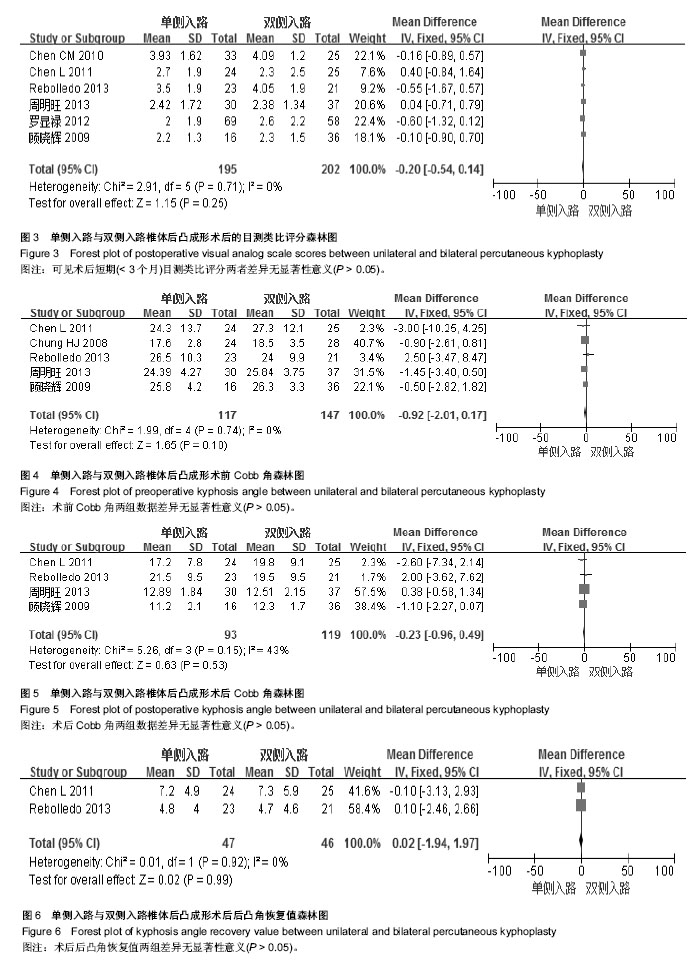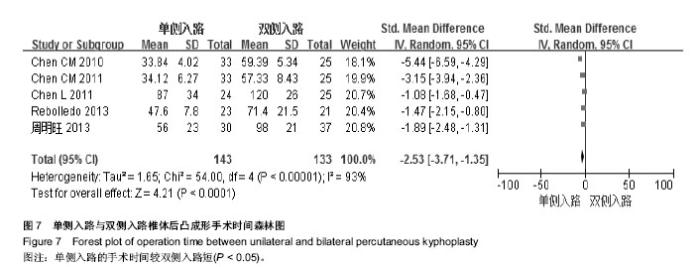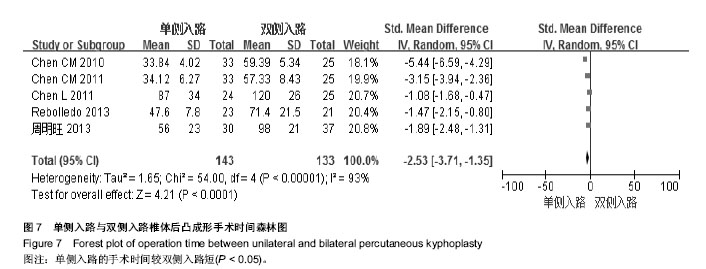Chinese Journal of Tissue Engineering Research ›› 2015, Vol. 19 ›› Issue (8): 1306-1312.doi: 10.3969/j.issn.2095-4344.2015.08.029
A systematic review on unilateral versus bilateral kyphoplasty for osteoporotic vertebral compression fractures
Yang Sen, Xu Tao, Sheng Wei-bin, Wang Guo-qi, Guo Hai-long
- Department of Spinal Surgery, the First Affiliated Hospital of Xinjiang Medical University, Urumqi 830054, Xinjiang Uygur Autonomous Region, China
-
Revised:2014-12-14Online:2015-02-19Published:2015-02-19 -
Contact:Guo Hai-long, Master, Chief physician, Associate professor, Master’s supervisor, Department of Spinal Surgery, the First Affiliated Hospital of Xinjiang Medical University, Urumqi 830054, Xinjiang Uygur Autonomous Region, China -
About author:Yang Sen, Studying for master’s degree, Department of Spinal Surgery, the First Affiliated Hospital of Xinjiang Medical University, Urumqi 830054, Xinjiang Uygur Autonomous Region, China
CLC Number:
Cite this article
Yang Sen, Xu Tao, Sheng Wei-bin, Wang Guo-qi, Guo Hai-long . A systematic review on unilateral versus bilateral kyphoplasty for osteoporotic vertebral compression fractures [J]. Chinese Journal of Tissue Engineering Research, 2015, 19(8): 1306-1312.
share this article
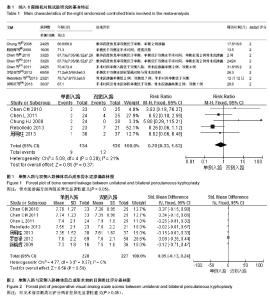
2.1 纳入文献情况及评分 纳入文献为8篇[7-14],包括507例患者和656个椎体,252例患者接受了单侧入路椎体后凸成形治疗,255例患者接受了双侧入路椎体后凸成形治疗。8篇文献Jadad评分均为低质量研究。纳入文献的基本特征具体见表1。 2.2 系统评价和Meta分析结果 2.2.1 骨水泥渗漏分析 纳入研究的8篇文献中,报道了有关骨水泥渗漏的有5篇[7,9,11,13-14],单侧入路组134个椎体中有9个椎体出现骨水泥渗漏,在双侧136个椎体中有13个椎体发生渗漏,将数据进行Meta分析,RR=0.7[0.33,1.53],同质性P=0.28,Z=0.89(P=0.37),表明两组在骨水泥渗漏方面差异无显著性意义,见图1。 2.2.2 骨水泥体积 纳入研究的8篇文献中,提供骨水泥体积的有4篇[10,12-14],包括296例患者和420个椎体。将数据进行Meta分析,均未发现存在异质性,固定效应模型被采用,P=0.27,[Z=8.51(P < 0.000 01),WMD=-1.86 (-2.28,-1.43)]。说明双侧与单侧在骨水泥含量方面差异有显著性意义,单侧入路骨水泥用量明显少于双侧入路。 2.2.3 目测类比评分 纳入研究的8篇文献中,提供目测类比评分术前数据7篇[8-14],术后短期随访(≤3个月)6 篇[8-9,11-14]、长期随访(≥12个月)5篇[10-14],将数据进行Meta分析,均未发现存在异质性,固定效应模型被采用。术前目测类比评分为P=0.57,[Z=0.56(P=0.58),WMD=-0.05 (-0.13,0.24)],短期随访(≤3个月)为P=0.71,[Z=1.15(P=0.25),WMD=-0.20 (-0.54,0.14)],或长期随访(≥12个月)为P=0.97,[Z=0.46(P=0.64),WMD=-0.08 (-0.27,0.44)],因此显示单侧与双侧入路在目测类比评分方面差异无显著性意义(见图2,3)。 2.2.4 ODI 纳入研究的8篇文献中,提供Oswestry 功能障碍指数术前数据的3篇[11-13],术后短期随访(≤ 3个月) 3篇[11-13]、长期随访(≥12个月)2篇[11,13],将数据进行Meta分析,均未发现存在异质性,固定效应模型被采用。术前ODI为P=0.40,[Z=0.68(P=0.49),WMD=0.45(-0.83,1.73)],短期随访(≤3个月)为P=0.21[Z=0.35(P=0.73),WMD=-0.13(-0.85,0.59)],或长期随访(≥1年)为P=0.16,[Z=0.24(P=0.81),WMD=-0.26(-2.44,1.92)],均无异质性,因此使用固定效应模型,显示单侧与双侧入路在ODI方面差异无显著性意义。 2.2.5 影像学结果 纳入研究的8篇文献中,描述术前后凸角有5篇[7-8 11,13-14],平均减少角度有3篇[11,13-14],提供恢复率的有2篇[7,9]。提供角度的减少细节有2篇[7,10],影像学分析包括术前、术后后凸角及术后角度恢复值。结果显示单侧入路和双侧之间差异无显著性意义,分别见图4-6。 2.2.6 手术时间 纳入研究的8篇文献中,提供具体的手术时间的有5篇[9-11,13-14],包括的276例患者,将数据进行Meta分析,P=0.00,I2= 93%,存在异质性,采用随机效应模型。结果为Z=4.21(P < 0.000 01),WMD =-2.53 (-3.71,-1.35),表明单侧入路与双侧入路在手术时间上差异有显著性意义,单侧入路的手术时间更少,见图7。"
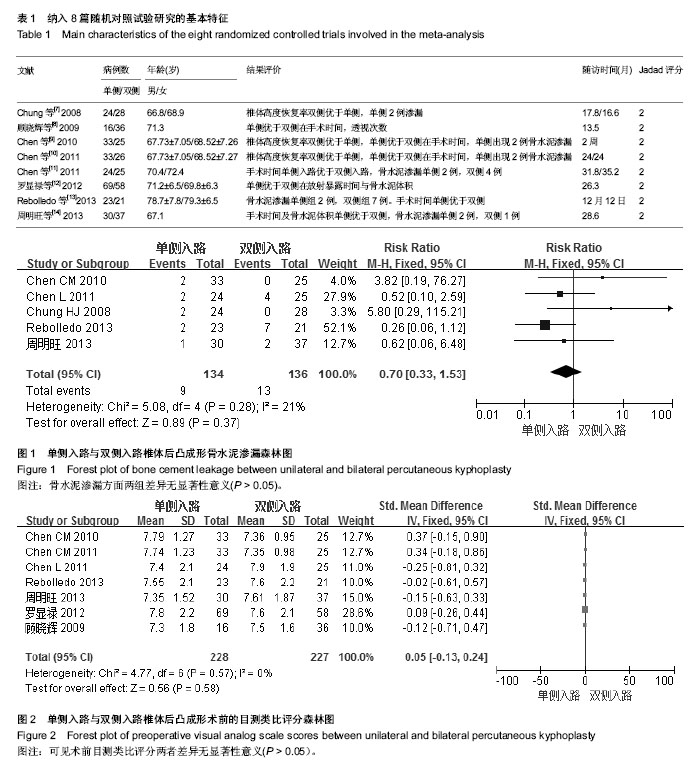
| [1] Mayumi S, Naoto E, Takeo O, et al. Incidence of osteoporotic fractures in SadoJapan in 2010.J Bone Mineral Metab. 2014; 32(2):200-200. [2] Russel B, Bess DH, Daniel HS, et al. Incidence and economic burden of osteoporosis - related fractures in the United States,2005 -2025. J Bone Mineral Res. 2007;22(3): 2005-2065. [3] Cockerill W, Lunt M, Silman AJ. Health - related quality of life and radiographic vertebral fracture. Osteop Int. 2004;15(2): 113-119. [4] Lieberman IH, Dudeney S, Reinhardt MK, et al. Initial outcome and efficacy of kyphoplasty in the treatment of painful osteoporotic vertebral compression fractures.Spine, 2001; 26(14):1631-1638. [5] Esses SI, McGuire R, Jenkins J, et al. The treatment of symptomatic osteoporotic spinal compression fractures.J Am Acad Orthop Surg. 2011;19(3):176-182. [6] Theodorou DJ, Theodorou SJ, Duncan TD, et al. Percutaneous balloon kyphoplasty for the correction of spinal deformity in painful vertebral body compression fractures.Clin Imaging. 2002;26(1):1-5. [7] Chung HJ, Chung KJ, Yoon HS, et al.Comparative study of balloon kyphoplasty with unilateral versus bilateral approach in osteoporotic vertebral compression fractures. Int Orthop. 2008;32(32):817-820. [8] 顾晓辉,张喆,吴健,等.单双入路后凸成形术治疗胸腰椎压缩骨折比较[J].中国中西医结合杂志, 2009, 15(3):246-249. [9] Chen CM, Gu Y, Xu Y, et al. Kyphoplasty for chronic painful osteoporotic vertebral compression fractures via unipedicular versus bipedicular approachment : A comparative study in early stage. Injury. 2010;41(4):356-359. [10] Chen CM, Wei HF, Zhang WN, et al. Comparative study of kyphoplasty for chronic painful osteoporotic vertebral compression fractures via unipedicular versus bipedicular approach. J Spinal Dis Tech. 2011; 24(7):E62-65. [11] Chen L, Yang HL, Tang TS. Unilateral versus bilateral balloon kyphoplasty for multilevel osteoporotic vertebral compression fractures : a prospective study. Spine (Phila Pa 1976). 2011; 36(7):534-540. [12] 罗显禄,郑昌坤,勘武生,等.经皮椎体后凸成形单侧与双侧穿刺注入骨水泥治疗骨质疏松性骨折[J].中国组织工程研究, 2012, 16(3): 567-570. [13] Rebolledo BJ, Gladnick BP, Unnanuntana A, et al. Comparison of unipedicular and bipedicular balloon kyphoplasty for the treatment of osteoporotic vertebral compression fractures:a prospective randomised study. Bone Joint. 2013;95(B):401-406. [14] 周明旺,李盛华,柳海平,等.单、双侧球囊扩张椎体后凸成形术治疗老年胸腰椎压缩骨折疗效分析[J].中国骨质疏松杂志, 2013, 19(3):488-490. [15] Taylor RS, Taylor RJ, Fritzell P. Balloon kyphoplasty and vertebroplasty for vertebral compression fractures : a comparative systematic review of efficacy and safety. Spine. 2006;31(23):2747-2755. [16] Esses SI, McGuire R, Jenkins J, et al. The treatment of symptomatic osteoporotic spinal compression fractures. J Am Acad Orthop Surg. 2011;19(3):176-182. [17] 李涛,朱裕成,郑红兵,等.经皮椎体后凸成形术中单双侧经椎弓根穿刺路径的选择[J].中国矫形外科杂志, 2009, 17(24): 1863-1865. [18] Belkoff SM, Mathis JM, Jasper LE, et al. The biomechanics of vertebroplasty.The effect of cement volume on mechanical behavior. Spine. 2001;26(26):1537-1541. [19] 李菊根,廖壮文,范子文,等.单侧与双侧椎弓根入路椎体成形术治疗高龄骨质疏松性椎体压缩骨折的临床疗效比较[J].中国微创外科杂志, 2013, 13(6):531-533. [20] Rousing R, Andersen MO, Jespersen SM, et al.Percutaneous vertebroplasty compared to conservative treatment in patients with painful acute or subacute osteoporotic vertebral fractures:three-month follow-up in a clinical randomized study. Spine. 2009;34(13):1349-1354. [21] Song BK, Eun JR, Oh YM. Clinical and radiological comparison of unipedicular versus bipedicular balloon kyphoplasty for the treatment of vertebral compression fractures. Osteoporos Int. 2009;20(20):1717-1723. [22] Liebschner MA, Rosenberg WS, Keaveny TM. Effects of bone cement volume and distribution on vertebral stiffness after vertebroplasty. Spine (Phila Pa 1976). 2001;26(14): 1547-1554. [23] Tohmeh AG, Mathis JM, Fenton DC, et al. Biomechanical efficacy of unipedicular versus bipedicular vertebroplasty for the management of osteoporotic compression fractures.Spine (Phila Pa 1976). 1999;24(17):1772-1776. [24] Mroz TE, Yamashita T, Davros WJ, et al. Radiation exposure to the surgeon and the patient during kyphoplasty. J Spinal Disord Tech. 2008;21(2):96-100. [25] 王建儒,张奎渤,刘辉,等. 经皮椎体后凸成形术术中不同辐射防护距离的对比研究[J].中国脊柱脊髓杂志,2014,24(5):417-421. [26] Hulme PA, Krebs J, Ferguson SJ, et al.Vertebroplasty and kyphoplasty : a systematic review of 69 clinical studies. Spine. 2006;31(17):1983-2001. 14:45 2015-4-3 |
| [1] | Wu Liang-hao, Yu Bao-qing, Chen Fan-cheng. Supercapsular percutaneously-assisted total hip approach for the elderly with femoral neck fractures: study protocol for a prospective, open-label, randomized, controlled clinical trial [J]. Chinese Journal of Tissue Engineering Research, 2017, 21(7): 1009-1014. |
| [2] | Chen Qun-qun, Qiao Rong-qin, Duan Rui-qi, Hu Nian-hong, Li Zhao, Shao Min. Acu-Loc®2 volar distal radius bone plate system for repairing type C fracture of distal radius [J]. Chinese Journal of Tissue Engineering Research, 2017, 21(7): 1025-1030. |
| [3] | Li Jing, Yang Long, Wang Jian-ji, Liu Qin, Zou Qiang, Sun Yu, Ma Min-xian, Ye Chuan. Three-dimensional reconstruction based on DICOM data and its application for orthopedic implants [J]. Chinese Journal of Tissue Engineering Research, 2017, 21(7): 1046-1051. |
| [4] | Ye Xiang-yang, Sun Xiang, Tang Li-xin, Zhen Ping, Geng Bin, Wang Hua-lei, Zhao Yu-guo. Acetabular liner wear of cross-linked versus conventional polyethylene for total hip arthroplasty: a meta-analysis [J]. Chinese Journal of Tissue Engineering Research, 2017, 21(7): 1143-1148. |
| [5] | Wang Ling, Zhao Hong-xia, Hua Qiang. Percutaneous vertebroplasty, percutaneous kyphoplasty and expansive pedicle screw fixation for repairing primary osteoporotic thoracolumbar fractures [J]. Chinese Journal of Tissue Engineering Research, 2017, 21(3): 350-355. |
| [6] | Zou Wei, Xiao Jie, Long Hao, Zhang Yang, Wu Chen, Du Yu-hui, Feng Ming-xing, Zhou Chang-jun. Screw placement selection of minimally invasive percutaneous pedicle screw fixation for thoracolumbar fractures [J]. Chinese Journal of Tissue Engineering Research, 2017, 21(3): 356-361. |
| [7] | Jia Yan-bo, Liang Zi-hong, Ren Yi-zhong, Han Chang-xu, Kong Ling-yue, Eerduntu. Tibial avulsion fractures of anterior cruciate ligament repaired with Arthrex sutures passing through combining free knotting technique [J]. Chinese Journal of Tissue Engineering Research, 2017, 21(3): 367-372. |
| [8] | Lu Zhong-lin, Cao Zhi-qiang, Gao Guo-liang, Jing Qing-ling, Zhang Wei, Huang Yong. Incidence and risk factors of deep vein thrombosis during waiting period before operation for calcaneal fractures by ultrasound elastography [J]. Chinese Journal of Tissue Engineering Research, 2017, 21(3): 423-427. |
| [9] | Zhang Tai-liang, Zhang Lei, Lian Zhi-ming, Yang Guang-zhong. Effect of remnant preservation on recovery of knee proprioception in arthroscopic anterior cruciate ligament reconstruction: a meta-analysis [J]. Chinese Journal of Tissue Engineering Research, 2017, 21(3): 471-477. |
| [10] | Zha Yuan-yu, Yang Yang, Chen Shu-zhen, Wei Ren-xiong, Zhang Shu-wei, Jin Wei. Meta-analysis of posterior laminectomy and instrumented fusion versus laminoplasty in treatment of multilevel cervical spondylotic myelopathy [J]. Chinese Journal of Tissue Engineering Research, 2017, 21(3): 485-492. |
| [11] | Hu Jun, Zhang De-qiang, Tang Xin. Postoperative quality of life of internal fixation versus hemiarthroplasty for femoral neck fractures in the elderly [J]. Chinese Journal of Tissue Engineering Research, 2017, 21(19): 2953-2960. |
| [12] | Sun Hao, Wei Jun-qiang, Liu Li-rui, Yan Shi, Jin Yu, Feng Zhen. Time of lower extremity deep venous thrombosis after hip arthroplasty in senile patients with osteoporotic femoral neck fractures [J]. Chinese Journal of Tissue Engineering Research, 2017, 21(19): 2961-2965. |
| [13] | Wang Xiu-ping, Sun Rui-bo, Liu You-wen, Zhang Ying, Jia Yu-dong, Yang Yu-xia, Wang Hui-chao. Femoral neck fractures fixed with intramedullary cannulated screws: factors for postoperative functional recovery [J]. Chinese Journal of Tissue Engineering Research, 2017, 21(19): 2999-3004. |
| [14] | Bai Zhao-hui, Zhang Ying, Yin Qing-shui, Xia Hong, Wang Jian-hua, Xu Jun-jie. Navigational template applied in the orthopaedic field in China: a bibliometric analysis [J]. Chinese Journal of Tissue Engineering Research, 2017, 21(19): 3023-3030. |
| [15] | Qiu Hao, Lu Min-peng, Dong Jing, Zhang Zhong-zu, Chu Tong-wei, Wang Qun-bo, Quan Zheng-xue, Jiang Dian-ming. Subtotal corpectomy and reconstruction with titanium mesh cage implantation and pedicle screw fixation through posterior approach in treatment of thoracolumbar burst fracture or thoracolumbar fracture dislocation [J]. Chinese Journal of Tissue Engineering Research, 2016, 20(53): 7932-7938. |
| Viewed | ||||||
|
Full text |
|
|||||
|
Abstract |
|
|||||
